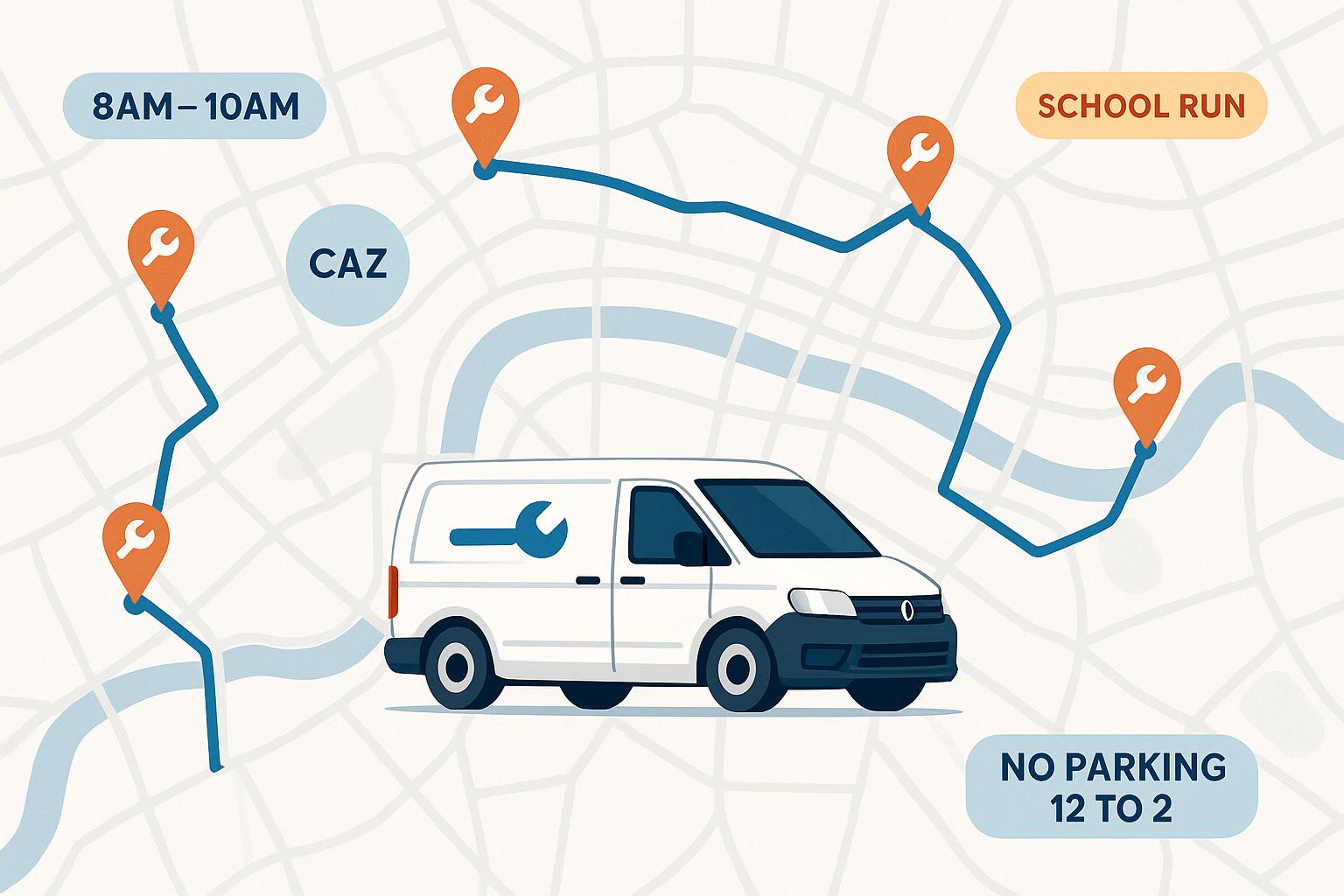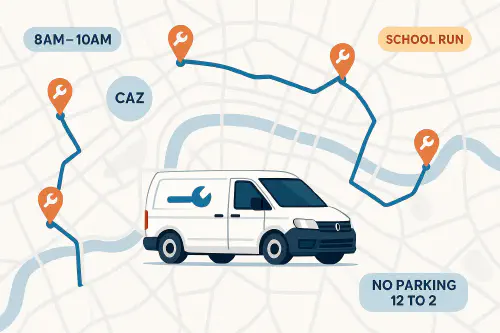
Micro-scheduling for one‑van plumbers: cut drive time and add one extra job a day
Micro-scheduling for one‑van plumbers: cut drive time and add one extra job a day
Category: Case Studies & Playbooks • Niche: scheduling, route optimisation, dispatch, Google Maps, ServiceM8/Tradify
Contents
- Quick answer
- Who this is for
- What micro‑scheduling is
- 30‑minute setup
- Daily routine that works
- Handle emergencies without blowing the day
- Measure the impact
- FAQs

White service van over a simplified London map with a 6‑stop optimised route and timing constraints
Quick answer
Micro‑scheduling is a simple way to plan your day around real‑world constraints like traffic, school runs, permits and parts pick‑ups. Using Google Maps, a basic spreadsheet and your job app (ServiceM8, Tradify, Commusoft or similar), you can cluster jobs, set realistic windows, and reduce zig‑zagging across town. Most one‑van plumbers can save 45–90 minutes of drive time per day and fit in one extra chargeable visit.
Who this is for
- Sole traders and small plumbing firms that cover a tight local patch.
- Anyone who books a mix of emergencies and planned works.
- Teams using job software but still firefighting travel and rescheduling.
What micro‑scheduling is
Instead of booking jobs as they come in, you:
- Cluster by postcode or 15–20 minute drive radius.
- Set AM/PM windows not exact times for most visits.
- Reserve two short “float” slots for overruns or urgent calls.
- Lock fixed points like merchant runs, school zones and CAZ charges.
This is not expensive software. It’s a playbook you can run with tools you already have.
30‑minute setup
- Create a simple job sheet
- Columns: Job ID, postcode, promised window (AM/PM), duration, priority, key constraints (parking, pets, school hours), parts ready (Y/N).
- You can do this in Google Sheets and link it to your job app via Zapier/Make later.
- Build a local cluster map
- Drop all today’s postcodes into Google My Maps.
- Colour code by priority and promised window.
- Aim for two clusters: morning and afternoon.
- Add fixed points and blockers
- Put in merchant pick‑ups and tip runs.
- Note school run hotspots, roadworks and local Clean Air Zone windows. See Checkatrade on route optimisation for trades and Salesforce field‑service explainer.
- Plan the order
- Use Google Maps “Add stop” then “Optimize” by dragging to minimise backtracking.
- Book AM stops 1–3 in one cluster, PM stops 4–6 in the next.
- Set buffers
- Add 10 minutes per stop for parking and client chat.
- Keep two 30‑minute float slots, one before lunch and one late afternoon.
Daily routine that works
Morning (15 minutes):
- Check traffic and weather; swap any outdoor jobs if high winds or rain. See our weather‑aware WhatsApp scheduling setup.
- Confirm AM windows by SMS or WhatsApp quick message templates in your job app.
On the road:
- When a job overruns by more than 15 minutes, move the float slot forward and auto‑notify the next customer.
- If a part is missing, reschedule to tomorrow’s cluster, not later the same day.
End of day (10 minutes):
- Review actual drive time vs plan. Adjust tomorrow’s clusters and buffers.
Handle emergencies without blowing the day
- Use the nearest‑next rule: only take an emergency if it’s within 15–20 minutes of your current cluster.
- Push the lowest‑priority job to tomorrow’s first slot and send an apology/update by WhatsApp.
- Keep a tiny emergency kit in the van to finish small extras without a merchant run.
Measure the impact
Track for one week:
- Total miles driven per day.
- Drive minutes vs on‑site minutes.
- Number of jobs completed.
Most solo plumbers see:
- 15–25 percent fewer miles.
- One extra completed job on 3–4 days a week.
- Fewer missed windows and callbacks because you arrive less stressed.
Handy tools and links
- Google My Maps for quick clustering: free and fast.
- Google Maps multi‑stop routing: add up to 10 stops per run.
- Check roadworks and incidents in your area with AA Route Planner
- If you grow to multiple vans, see our Dispatcher playbook for trades.
What trades are asking right now
- “Best plumber scheduling app?” You don’t need to switch apps to see gains; start with the playbook above. If you’re choosing software, UK‑friendly options include Gas Engineer Software, Commusoft and Tradify. See comparison roundups on Checkatrade and vendor pages like Commusoft plumbing software.
- “Route planner with multiple stops?” Google Maps handles 10 stops and is fine for one van. For larger lists try Webfleet, Routific or OptimoRoute roundups via HSE Network.
Simple flow to copy

Flow showing cluster planning and constraints like CAZ and school run
- Inputs: today’s jobs, postcodes, constraints, parts ready.
- Process: cluster, order, buffer, confirm.
- Outputs: AM cluster route, PM cluster route, two float slots.
FAQs
Is this worth it if most of my work is emergencies?
Yes. Clustering even half your day reduces zig‑zags. Use the nearest‑next rule and only accept emergencies near your current run.
Do I need paid route software?
Not to start. Google Maps plus My Maps gets you 80 percent of the value. Add specialist tools only when you hit their limits.
How do I handle parking restrictions?
Add them as constraints in your sheet and avoid booking during no‑parking windows. If unavoidable, put the job at the top of a cluster so you arrive on time and leave quickly.
Can I automate client messages?
Yes. Most job apps send SMS/WhatsApp reminders. Keep messages short: “Plumber en route, due between 10:00–12:00. Reply 1 to confirm, 2 to reschedule.”
Want to slash training times and increase revenue per Engineer? Join our Waitlist: https://trainar.ai/waitlist